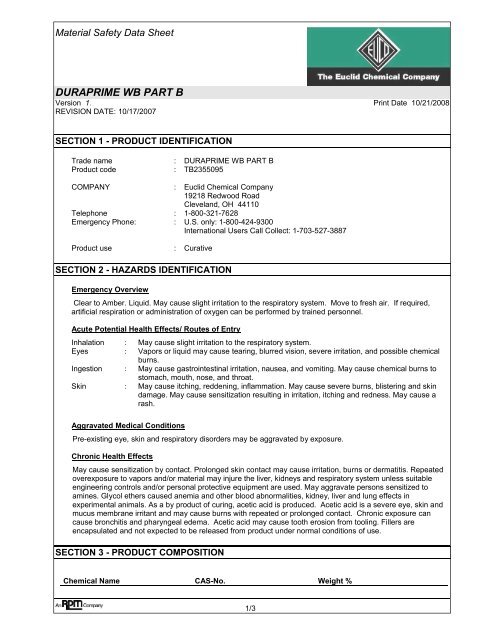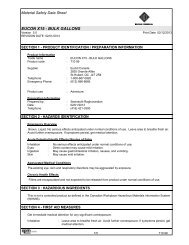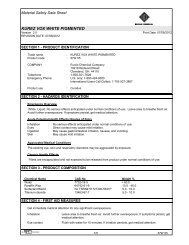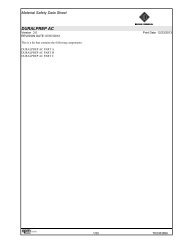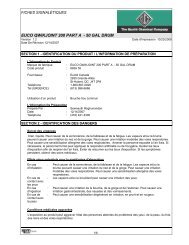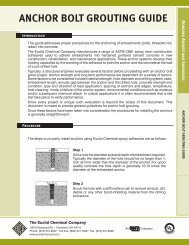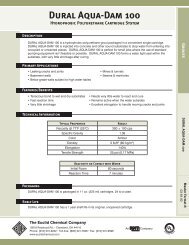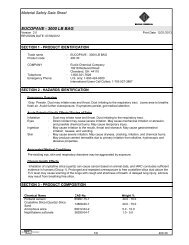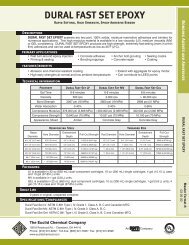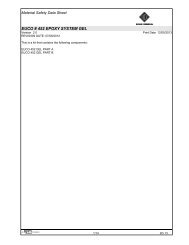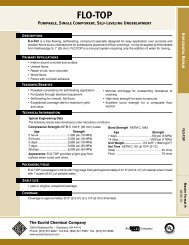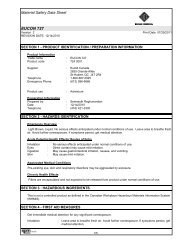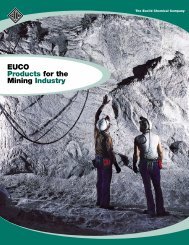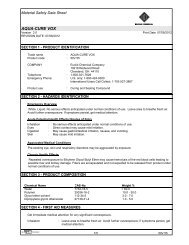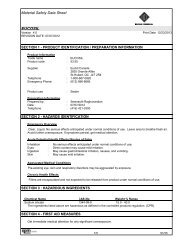DURAPRIME WB PART B - Euclid Chemical Co
DURAPRIME WB PART B - Euclid Chemical Co
DURAPRIME WB PART B - Euclid Chemical Co
You also want an ePaper? Increase the reach of your titles
YUMPU automatically turns print PDFs into web optimized ePapers that Google loves.
Material Safety Data Sheet<strong>DURAPRIME</strong> <strong>WB</strong> <strong>PART</strong> BVersion 1. Print Date 10/21/2008REVISION DATE: 10/17/2007SECTION 1 - PRODUCT IDENTIFICATIONTrade name : <strong>DURAPRIME</strong> <strong>WB</strong> <strong>PART</strong> BProduct code : TB2355095COMPANY : <strong>Euclid</strong> <strong>Chemical</strong> <strong>Co</strong>mpany19218 Redwood RoadCleveland, OH 44110Telephone : 1-800-321-7628Emergency Phone: : U.S. only: 1-800-424-9300International Users Call <strong>Co</strong>llect: 1-703-527-3887Product use : CurativeSECTION 2 - HAZARDS IDENTIFICATIONEmergency OverviewClear to Amber. Liquid. May cause slight irritation to the respiratory system. Move to fresh air. If required,artificial respiration or administration of oxygen can be performed by trained personnel.Acute Potential Health Effects/ Routes of EntryInhalation : May cause slight irritation to the respiratory system.Eyes : Vapors or liquid may cause tearing, blurred vision, severe irritation, and possible chemicalburns.Ingestion : May cause gastrointestinal irritation, nausea, and vomiting. May cause chemical burns tostomach, mouth, nose, and throat.Skin : May cause itching, reddening, inflammation. May cause severe burns, blistering and skindamage. May cause sensitization resulting in irritation, itching and redness. May cause arash.Aggravated Medical <strong>Co</strong>nditionsPre-existing eye, skin and respiratory disorders may be aggravated by exposure.Chronic Health EffectsMay cause sensitization by contact. Prolonged skin contact may cause irritation, burns or dermatitis. Repeatedoverexposure to vapors and/or material may injure the liver, kidneys and respiratory system unless suitableengineering controls and/or personal protective equipment are used. May aggravate persons sensitized toamines. Glycol ethers caused anemia and other blood abnormalities, kidney, liver and lung effects inexperimental animals. As a by product of curing, acetic acid is produced. Acetic acid is a severe eye, skin andmucus membrane irritant and may cause burns with repeated or prolonged contact. Chronic exposure cancause bronchitis and pharyngeal edema. Acetic acid may cause tooth erosion from tooling. Fillers areencapsulated and not expected to be released from product under normal conditions of use.SECTION 3 - PRODUCT COMPOSITION<strong>Chemical</strong> Name CAS-No. Weight %1/3
Material Safety Data Sheet<strong>DURAPRIME</strong> <strong>WB</strong> <strong>PART</strong> BVersion 1. Print Date 10/21/2008REVISION DATE: 10/17/2007Water 7732-18-5 > 60.0Aliphatic Polyamine NJ TSRN# 51721300-5678P 15.0 - 40.02-Propoxyethanol (Glycol ether) 2807-30-9 3.0 - 7.0Acetic acid 64-19-7 1.0 - 5.0SECTION 4 - FIRST AID MEASURESGet immediate medical attention for any significant overexposure.Inhalation : Move to fresh air. If required, artificial respiration or administration of oxygen can beperformed by trained personnel.Eye contact : Flush with water for at least 15 minutes while holding eye lids apart. Get medicalattention immediately.Skin contact : Clean area of contact thoroughly using soap and water. If irritation, rash or otherdisorders develop, get medical attention immediately.Ingestion : Do not induce vomiting unless advised by a physician. Call nearest Poison <strong>Co</strong>ntrolCenter or Physician immediately.SECTION 5 - FIRE FIGHTING MEASURESFlash point : Not available.Method : Not available.Lower explosion limit : Not available.Upper explosion limit : Not available.Autoignition temperature : Not available.Extinguishing media : If water fog is ineffective, use carbon dioxide, dry chemical or foam.Hazardous combustionproductsProtective equipment forfirefighters: Carbon monoxide and carbon dioxide can form.Smoke, fumes.Nitrogenoxides can form.: Use accepted fire fighting techniques. Wear full firefighting protectiveclothing, including self-contained breathing apparatus (SCBA).Fire and explosion conditions : Product may ignite if heated in excess of its flash point.Vapors maytravel to sources of ignition and flashback.Vapor concentrations inenclosed areas may ignite explosively.Empty containers may containignitable vapors.SECTION 6 - ACCIDENTAL RELEASE MEASURESUse appropriate protective equipment. Avoid contact with material. Remove sources of ignition immediately.Stop flow of material if safe to do so. <strong>Co</strong>ntain spill and keep out of water courses. Ventilate area.SECTION 7 - HANDLING AND STORAGEPrevent inhalation of vapor, ingestion, and contact with skin eyes and clothing. Keep container closed whennot in use. Precautions also apply to emptied containers. Do not smoke, weld, generate sparks, or use flamenear container. Do not use in confined or poorly ventilated areas. Personal protective equipment must be worn2/3
Material Safety Data Sheet<strong>DURAPRIME</strong> <strong>WB</strong> <strong>PART</strong> BVersion 1. Print Date 10/21/2008REVISION DATE: 10/17/2007during maintenance or repair of contaminated mixer, reactor, or other equipment. Store under dry warehouseconditions away from heat and all ignition sources.SECTION 8 - EXPOSURE CONTROLS / PERSONAL PROTECTIONPersonal protection equipmentRespiratory protection : Wear NIOSH/MSHA approved vapor respirator with appropriate cartridgewhen the vapor concentration is expected to exceed exposure limits indicatedon the MSDS. Follow manufacturer's directions for respirator use.Hand protection : Use suitable impervious nitrile or neoprene gloves and protective apparel toreduce exposure.Eye protection : Wear chemical safety goggles and/or face shield to prevent eye contact. Donot wear contact lenses. Do not touch eyes with contaminated body parts ormaterials. Have eye washing facilities readily available.Skin and body protection : Prevent contact with shoes and clothing. Use rubber apron and overshoes.Protective measures : Inspect and replace equipment at regular intervals.Use professional judgmentin the selection, care, and use.Engineering measures : Use only in well ventilated areas. Provide maximum ventilation in enclosedareas.Use local exhaust when the general ventilation is inadequate.Exposure Limits<strong>Chemical</strong> Name CAS Number Regulation Limit FormAcetic acid 64-19-7 ACGIH TWA: 10 ppmACGIH STEL: 15 ppmOSHA PEL: 25 mg/m3SECTION 9 - PHYSICAL AND CHEMICAL PROPERTIESForm : Liquid<strong>Co</strong>lor : Clear to AmberOdor : AminepH : 9 - 10Vapour pressure : Not available.Vapor density : Heavier than airMelting point/range : Not available.Freezing point : Not available.Boiling point/range : Not available.Water solubility : NegligibleSpecific Gravity : 0.990% Volatile Weight : 78.3 %3/3
Material Safety Data Sheet<strong>DURAPRIME</strong> <strong>WB</strong> <strong>PART</strong> BVersion 1. Print Date 10/21/2008REVISION DATE: 10/17/2007SECTION 10 - REACTIVITY / STABILITYSubstances to avoid : Oxidizing agents.Epoxies.Isocyanates.Acids.Stability : Material is stable under normal storage, handling, and use.Hazardous polymerization : Will not occur under normal conditions.SECTION 11 - TOXICOLOGICAL INFORMATION2-Propoxyethanol (Glycol ether), CAS-No.: 2807-30-9Acute oral toxicity (LD-50 oral) 4,450 mg/kg ( Rat ) 2,400 mg/kg ( Mouse )Acute inhalation toxicity (LC-50) 1,530 mg/l for 7 h ( Rat )Acute dermal toxicity (LD-50 dermal) 870 mg/kg ( Rabbit )Acetic acid, CAS-No.: 64-19-7Acute oral toxicity (LD-50 oral) 3,530 mg/kg ( Rat ) 3,530 mg/kg ( Rat )Acute inhalation toxicity (LC-50) 5,000 mg/l ( Mouse ) 5,000 mg/l ( Guinea pig ) 5,000 mg/l for1 h ( Guinea pig ) 5,000 mg/l for 1 h ( Mouse )SECTION 12 - ECOLOGICAL INFORMATIONNo Data AvailableSECTION 13 - DISPOSAL CONSIDERATIONSDisposal Method : Subject to hazardous waste treatment, storage, and disposal requirements underRCRA. Recycle or incinerate waste at EPA approved facility or dispose of incompliance with federal, state and local regulations.SECTION 14 - TRANSPORTATION / SHIPPING DATATDG / DOT Shipping Description:NOT REGULATEDSECTION 15 - REGULATORY INFORMATIONNorth American Inventories:All components are listed or exempt from the TSCA inventory.This product or its components are listed on, or exempt from the Canadian Domestic Substances List.U.S. Federal Regulations:SARA 313 <strong>Co</strong>mponents : 2-Propoxyethanol (Glycol ether) 2807-30-9SARA 311/312 Hazards : Acute Health Hazard4/4
Material Safety Data Sheet<strong>DURAPRIME</strong> <strong>WB</strong> <strong>PART</strong> BVersion 1. Print Date 10/21/2008REVISION DATE: 10/17/2007OSHA Hazardous <strong>Co</strong>mponents :2-Propoxyethanol (Glycol ether) 2807-30-9Acetic acid 64-19-7OSHA Status: <strong>Co</strong>nsideredhazardous based on thefollowing criteria:: IrritantOSHA Flammability : Not RegulatedWhen appropriately mixed with the other part, product has a VOC less water and exempt solvent of:50 g/lU.S. State Regulations:MASS RTK <strong>Co</strong>mponents : Acetic acid 64-19-7Penn RTK <strong>Co</strong>mponents : Water 7732-18-5Aliphatic Polyamine NJ TSRN# 51721300-5678P2-Propoxyethanol (Glycol ether) 2807-30-9Acetic acid 64-19-7NJ RTK <strong>Co</strong>mponents : Water 7732-18-5Aliphatic Polyamine NJ TSRN# 51721300-5678P2-Propoxyethanol (Glycol ether) 2807-30-9Acetic acid 64-19-7WARNING! <strong>Co</strong>ntains chemicals known to the State of California to cause cancer, birth defects and/or otherreproductive harm:None known.SECTION 16 - OTHER INFORMATIONHMIS Rating :Health 1Flammability 0Reactivity 0PPE0 = Minimum1 = Slight2 = Moderate3 = Serious4 = SevereFurther information:For Industrial Use Only. Keep out of Reach of Children. The hazard information herein is offered solely for theconsideration of the user, subject to their own investigation of compliance with applicable regulations, includingthe safe use of the product under every foreseeable condition.Prepared by: Rich MikolLegendACGIH - American <strong>Co</strong>nference of Governmental HygienistsCERCLA - <strong>Co</strong>mprehensive Environmental Response, <strong>Co</strong>mpensation, andLiability ActDOT - Department of TransportationDSL - Domestic Substance ListPEL - Permissible Exposure LimitRCRA - Resource <strong>Co</strong>nservation and Recovery ActRTK - Right To KnowSARA - Superfund Amendments and Reauthorization Act5/5
Material Safety Data Sheet<strong>DURAPRIME</strong> <strong>WB</strong> <strong>PART</strong> BVersion 1. Print Date 10/21/2008REVISION DATE: 10/17/2007EPA - Environmental Protection AgencyHMIS - Hazardous Materials Information SystemIARC - International Agency for Research on CancerMSHA - Mine Safety Health AdministrationNDSL - Non-Domestic Substance ListNIOSH - National Institute for Occupational Safety and HealthNTP - National Toxicology ProgramOSHA - Occupational Safety and Health AdministrationSTEL - Short Term Exposure LimitTLV - Threshold Limit ValueTSCA - Toxic Substances <strong>Co</strong>ntrol ActTWA - Time Weighted AverageV - VolumeVOC - Volatile Organic <strong>Co</strong>mpoundWHMIS - Workplace Hazardous Materials InformationSystem6/6


